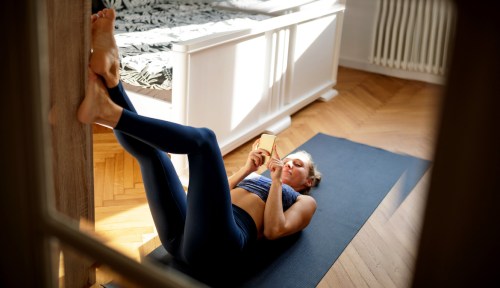Meet the Ab-Busting Move That Also Helps With Lower Back Pain: Dead Bug
If you're going to work the dead bug exercise into your next workout, you want to make sure your form is spot on. Follow these expert tips.

I
Experts in This Article
instructor at East River Pilates in New York City
ACE-certified personal trainer and founder and CEO of Studio SWEAT
Pilates instructor and core specialist
Of course, it did get its name from somewhere. Namely, the fact that you do essentially imitate a dead bug: Lying on your back, you put your feet in the air in table top position, arms reaching to the ceiling, then alternate extending opposite arms and legs.
It’s a serious move praised by countless trainers. “Don’t let the cute name fool you—the dead bug is a killer core exercise,” says Cat Kom, fitness expert and founder of Studio Sweat onDemand. “It’s amazing because it’s so simple, but can target your inner core muscles and spinal stabilizers—aka your obliques, transverse abdominis, rectus abdominis (your “six pack”), multifidus, diaphragm, and even your pelvic floor.”
“Don’t let the cute name fool you—the dead bug is a killer core exercise.” —Cat Kom
Unlike crunches, this move forces you to engage your inner core without putting pressure on your spine. “It allows you to raise your arms and move your legs without arching your lower back,” says Kom. The dead bug is all about isolation, which is nice and gentle on your joints. “It teaches your body to isolate your hip and shoulder movement without putting unnecessary tension on your back,” says Kom. “Because it targets the right muscles, it’s great for improving your motor control. All of these things are amazing if you have lower back problems.” Unsurprisingly, it’s highly recommended as a way for older adults to keep their core strong.
How to do the dead bug exercise the right way
Want to work the dead bug into your next workout? You’ll want to make sure your form is spot on—otherwise, it’s not going to do much for you. Follow these seven expert tips:
1. Avoid pressing your low back into the mat
“Instead, focus on keeping your pelvis parallel with your mat so that you activate your abdominals and don’t strain your back,” says Erica Ziel, author, personal trainer, and founder of Core Athletica.
2. Keep your breathing consistent
Remember to inhale as you extend your limbs and exhale as you return them to the starting position, taking deep, even breaths. “What we tend to do is fudge the breath work and put unnecessary activation into the quads and hip flexors,” says Brian Spencer of East River Pilates in this dead bug tutorial video for Well+Good.
3. Don’t turn it into a neck workout
If your neck tends to get irritated when flexing up, just keep your head down on the floor, suggests Ziel. You’ll still feel it plenty in your core. Also, “as you reach your arm overhead, try reaching from under your armpit rather than with your upper traps, which can put too much pull into your neck,” she adds.
4. Watch your tabletop form
It’s easy to overlook your starting point, but you’re gonna want to make sure those knees are directly over your hips in tabletop. “We tend to bring the knees too far in, automatically gripping those hip flexors and rounding that low back,” says Spencer.
5. Don’t worry about how far your limbs are extending
Focus less on how much you’re moving, and more on keeping proper (and safe) form. “Keep your knees bent rather than extending too far if you feel any tension in your lower back,” Ziel says. Only reach further once you feel everything in the right place. “It’s always better to build range of motion once you’ve gotten those correct muscles strengthened enough to stabilize this exercise, rather than going and dumping too much work into low back, hips, or quads,” Spencer says.
6. Go slow
“Form is everything, so breathe and control your cadence,” says Kom. “If you’re starting to fatigue or feel any strain in the back or neck, just bring the extended leg a little higher into the air, so it’s at more of an obtuse angle from your hip, rather than a straight line—the higher it is, the less load on your back.”
7. Once you’ve got dead bug down, try variations that kick things up a notch
If the traditional dead bug exercise isn’t challenging your core as much as you want, try the kolar dead bug, which uses a wall, or add in a mobility stick, like Jennifer Aniston’s trainer recommends. Your core will thank you.
Sign Up for Our Daily Newsletter
Get all the latest in wellness, trends, food, fitness, beauty, and more delivered right to your inbox.
Got it, you've been added to our email list.










